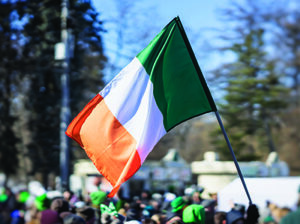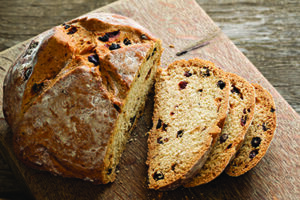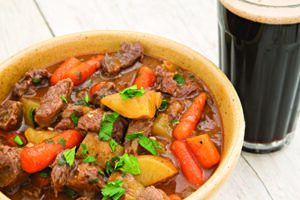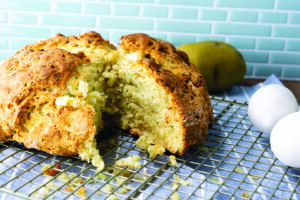The pipes are calling you
3/2/2022 A close friend of mine lived directly behind his elementary school. On St. Patrick’s Day in his fifth-grade year, he went to school without wearing any green. Shamed by classmates and his teacher, he walked home at lunch time, entered his family garage, foraged a partially used can of green paint, poured it over his head and returned to school, greener than anyone else.
A close friend of mine lived directly behind his elementary school. On St. Patrick’s Day in his fifth-grade year, he went to school without wearing any green. Shamed by classmates and his teacher, he walked home at lunch time, entered his family garage, foraged a partially used can of green paint, poured it over his head and returned to school, greener than anyone else.
Every year, millions of Americans, some Irish but just as many not, descend upon party tents, parade routes, Irish bars and restaurants, basketball tourneys and cultural celebrations decked in emerald green and often sporting shirts, panties, halter tops, green carnations and ball caps that proclaim the mantra of their day — “Kiss Me I’m Irish,” “Irish You Were Naked,” “American-made, Irish Parts,” “Shenanigans Coordinator,” “I’m Lucky, You Get Me,” and “Sinn Féin Amháin.”
One day every year, damn near everyone channels their inner Irish, or at least their inner Irish party person. Non-Italians don’t pretend to be Italian Americans on Columbus Day, or whatever wokes call that now. Non-Mexicans don’t wear the tres colores on Cinco de Mayo. Non-French don’t get drunk and sing “Le Marseillaise” on Bastille Day. What is it about the Irish persona that makes so many others want to play at being Irish on St. Patrick’s Day in America?
Lots of things play into the masquerade and the celebration. The history of the Irish is an easy thing with which to empathize. Irish beer is really good and is a huge part of Irish history. Same thing with the whiskey, which is never spelled whisky. Irish cuisine, particularly banbhianna, the great milk-sourced foods of the Emerald Isle, is special. Song and literature also spread the gospel of Irish identity in a dramatic manner.
Sympathy plays its part in the process. No other western Europeans suffered more, or were treated worse, in their native homeland. That comes out in the wearing of the green, which is deadly serious stuff.
Song of Ireland
Liverpool is often called “the real capital of Ireland” because it has the largest Irish population, even more than Dublin, if you count back two generations. To escape to America, all Irish had to first get to Liverpool. Many never made it any further. John Lennon and Paul McCartney both had parents born in Ireland. Two of George Harrison’s grandparents were Irish born. Paul and John both wrote and recorded songs about the plight of the Irish at British hands. Other Irishmen dominated British rock for 50 years.
The Beatles played Dublin and Belfast twice during their brief time together, at John’s insistence. After they broke up, John released his lament “Sunday Bloody Sunday.” That was in response to the Bogside Massacre of when British soldiers shot 26 and killed 13 unarmed civilians during a protest march in Derry, Northern Ireland. The song hit hard against the British:
“You Anglo pigs and Scottish sent to colonize the north/You want your bloody Union Jacks and you know what it’s worth/Well it was Sunday, bloody Sunday when they shot the people dead/The cries of 13 mothers filled the free Derry air/ Is there any amongst you dare to blame it on the kids?/Not a single soldier was bleeding when they nailed the coffin lids.”
Paul also recorded a response to the massacre, “Give Ireland Back to the Irish.” It was the first song recorded by Wings and suffered in comparison to Lennon’s piece for its restraint and simple lyrics. Paul’s song even praises Great Britain. Both songs were banned in the United Kingdom, though few in Northern Ireland obeyed. Some Beatles biographers think these two songs changed the perception of the two former songwriting partners, with John being taken seriously and Paul written off as trivial.
Irish music had been influencing people around the world, and particularly in America, to sympathize with the Irish. The island of bards, druids and poets exported its excruciatingly sentimental songs. American singers of direct Irish descent include Rosemary Clooney (and her nephew George), Marian Carey, Judy Garland, Pink, Alisha Keys, Christina Aguilera, Jeff and Tim Buckley, Kelly Clarkson, George M. Cohen, Kurt Cobain, Bing Crosby, Billie Eilish, John Fogerty, Tim McGraw, Jim Morrison, Jimi Hendrix, Kati Perry, Tom Petty, Bruce Springsteen, Taylor Swift, Justin Timberlake, Cory Taylor and a guy named Elvis.
The most dramatic moment at Elvis’ funeral was the playing of the old war lament “Danny Boy.” Elvis said the song was “written by the angels,” and he requested that his version be played at his funeral. It is probably the most famous version though many of opera’s greatest sopranos and tenors have covered it. It was written in 1912 by an Englishman after his Irish born sister sang a version to him. It was set in Ireland and stole the Irish tune “Londonderry Air.” It is traditionally sung at every funeral of Irish-American police officers and firefighters in New York, Chicago and Boston.
Another Irish song with unbearably sympathetic words and music is “Johnny, I Hardly Knew You.” It was published by an Englishman but was set in Ireland and copied an old Irish tune. It was written to encourage Irish resistance to being drafted by the English to fight in the Kandyan War of 1863. Similar was “When Johnny Comes Marching Home Again” sung to the same tune but written by an Irish-American to support the American Civil War. It became an anthem by hopeful supporters of both the Union and the Confederacy. It is an eerie, ironic song with positive lyrics accompanying music that is a tragic dirge.
In the tradition of pro-Northern Ireland independence, Irish singer/songwriter Sinead O’Connor released her moving “A Drink Before the War.” Its frustrating chorus says, “Listen to the man at the liquor store/He’s asking ‘Anybody wanna drink before the war?’” The implication is that the Irish have become utterly used to war and persecution.
The colors
More than everything else, one traditional song explains why Irish Americans and their wannabes don the green on St. Patrick’s Day: “The Wearin’ of the Green.” I have never listened to the Judy Garland version of it without tearing up.
Oh, Paddy dear and did you hear the news that’s goin’ round?
The shamrock is by law forbid to grow on Irish ground
Saint Patrick’s Day no more we’ll keep his colors can’t be seen
For they’re hangin’ men and women for the wearin’ of the green
I met with Napper Tandy and he took me by the hand
He said: “How’s dear old Ireland and how does she stand?”
She’s the most distressful country that you have ever seen
For they’re hangin’ men and women for the wearin’ of the green”
Then since the color we must wear is England’s cruel red
Sure Ireland’s sons will ne’er forget the blood that they have shed
You may take the shamrock from your hat and cast it on the sod
But ‘twill take root and flourish there though underfoot ‘tis trod
My father loved his country and sleeps within its breast
While I that would have died for her must never so be blessed
Those tears my mother shed for me how bitter they had been
If I had proved a traitor to the wearin’ of the green
But if at last our colors should be torn from Ireland’s heart
Her sons with shame and sorrow from the dear old isle will part
I’ve heard a whisper of a land that lies beyond the sea
Where rich and poor stand equal in the light of Freedom’s Day
Oh Ireland must we leave you driven by a tyrant’s hand
And seek a mother’s blessing from a strange and distant land
Where the cruel cross of England shall never more be seen
And in that land we’ll live and die still wearing Ireland’s green
For the wearin’ ot the green
The song became a popular street ballad in 1798 when, inspired by the American Revolutionary War, the Society of United Irishmen revolted against the British in County Wicklow. They were put down ruthlessly but took to the hills in a guerrilla resistance. The song suggests this was a pivotal moment in the Irish emigration to America, where proud Irishmen could wear the green. To this day, green is sported more in America than in Ireland on St. Patrick’s Day.
Whiskey and beer
The climate of Ireland is unusual to Europe. It is warmed, particularly its western half, by the Gulf Stream breezes. It also remains protected from most of the Arctic breezes that hit Scotland and the north of England hard. It has never been suitable for grape vines and has never produced much wine.
On the other hand, Ireland provides fabulous agricultural opportunities for growing grains like barley, rye and wheat. Those have been the source of Irish ales, beers and whiskeys. And never spell it “whisky.” That is what the Brits produce. Irish whiskey added the “e” for Eire to identify it as local and untaxed by the bloody Brits.
In America and Canada, this designation remained. Most Canadian distillers have been of Scottish or English sympathies and Canadian whisky eschews the “e.” One Canadian spirit was created at the request of English King George VI. He made a trans Canadian train trip to drum up support for an impending World War II. He only liked Bourbon and wanted Canada to create a spirit that resembled Bourbon more than Scotch, which he would not drink. Royal Crown was the result.
Most American whiskey makers were Irishmen who moved west to escape federal taxation. Today, all but one Bourbon maker includes the “e.” The exception is the Scottish founded Makers Mark.
This St. Patrick’s Day, two Iowa-made Irish red ales join the many imports available: Confluence’s Imogene Red and Fox’s Foxtail. Cedar Ridge, Iowa, Three Oaks, Artisan Grain, Broadbent, Legendary Rye (Templeton), Mississippi River, and Foundry distilleries all make a whiskey and all include the “e.” The Irish imported whiskey Jameson is amongst the most popular spirits in the state.
However, most of the singers mentioned above prefer Bushmills. Jameson was founded by a Scotsman, who, being Scottish was Protestant. Bushmills is the Catholic choice. In divided, ravaged Belfast and other Northern Ireland cities, towns are divided and identified by the whiskey their taverns advertise. The Irish Republican Army (IRA), supported by most ex patriated Irish singers, endorses the Bushmills brand.
Food
The food history of Ireland is much like that of the U.S. It was built piece by piece by a melting pot of immigrants and conquerors. The first settlers, some 6,000 years ago, brought new things to a land where survival depended upon fishing, hunting and foraging. Sheep, goats, small cows and grains were added to the diet by the earliest immigrants.
About 2,500 years ago, the first Celts entered Ireland likely in search of copper. They brought cauldrons, grains, swords, superior plows and, especially, cattle. After the eighth century, the Celts would dominate Ireland for a thousand years and so would cow culture. A rising population plus exhausted top soil ushered in a Dark Age of agriculture. The Celts didn’t care; their cattle, which they proudly looted from others, supplied nearly their entire diet. Their warriors preferred rustling to farming.
The resulting “white food” cuisine, called banbhianna, remains the proudest segment of Irish cuisine. The Celts lived on things made of sweet or sour milk — curds, butter, buttermilk (still the secret ingredient in the famous Irish soda bread), hard cheese, soft cheese, and cottage cheese. These were made from cow, goat and sheep milks. One hard cheese, Tanach, reached legendary standards when Queen Maeve was killed by a nephew who shot her in the head with Tanach from his slingshot. When the Brits virtually conquered Ireland, they did it by stealing the cattle and sending them to Britain, starving the Irish of banbhianna and meat. They justified this by claiming they were making the lazy, cattle-herding Celts into more productive workers, aka slaves.
The first Christians were monks who imported fruit and nut trees, plus new vegetables. The Normans would sophisticate farming and introduce new species of deer to replace the aboriginal, depleted stock of red deer. They also brought peas, beans, flax, new freshwater fish, and more sheep suitable for shearing and exporting wool. Vikings were traders who imported plums and other fruits, olive oil, wine and herbs to Ireland while exporting slaves, wool, metalwork and animal hides. Catholic German immigrants, escaping Protestant persecution after the Reformation, brought pigs. Because Ireland’s damp climate is not fit for drying and dry aging, Irish pork has always been mostly cured or smoked, with bacon being majesty of pig parts.
Sir Walter Raleigh is credited in dramatic lore for bringing potatoes to the isle, but there is little historic evidence that he was the guy. Regardless, the potato became the main food of Ireland. Its blight, caused by the fact that Raleigh, or whoever, only brought one potato species while the Incas who introduced him to it knew that multiple species and their interbreeding were essential to protect the plant from disease.
The potato famine of 1845 bumped up emigration to America even more than the brutal reaction to the uprisings of the previous century. The song that celebrates Ireland’s greatest culinary application of the potato, “Colcannon,” is traditional but became popular during “The Troubles” of the 20th century. It begins by asking:
“Did you ever eat Colcannon, made from lovely pickled cream? With the greens and scallions mingled like a picture in a dream. Did you ever make a hole on top, to hold the melting flake of flavored butter that your mother used to make?” and concludes with “Oh, wasn’t it the happy days when troubles we had not, and our mothers made Colcannon in the little skillet pot?”
Irish novelist Anthony Burgess (“A Clockwork Orange”) writes in his foreword to “The Joyce of Cooking” that “You can tell a bad novelist by the way he or she deals with eating. ‘They resumed their journey after breakfast.’ But what for God’s sake did they have for breakfast?” Burgess goes on to claim Irish writers rarely make this mistake and that James Joyce and Charles Dickens were the greatest novelists for observing eating.
So, channel your inner Irish this St. Paddy’s Day with the food and song, the ale and whiskey, the love of freedom and joy of life that are forever Ireland, wherever you might be. ♦
























“American singers of direct Irish descent include Rosemary Clooney (and her nephew George), Marian Carey, Judy Garland, Pink, Alisha Keys, Christina Aguilera, Jeff and Tim Buckley, Kelly Clarkson, George M. Cohen, Kurt Cobain, Bing Crosby, Billie Eilish, John Fogerty, Tim McGraw, Jim Morrison, Jimi Hendrix, Kati Perry, Tom Petty, Bruce Springsteen, Taylor Swift, Justin Timberlake, Cory Taylor and a guy named Elvis.”
Um, no, it’s Mariah Carey, Alicia Keys, George M. Cohan, Katy Perry and Corey Taylor.